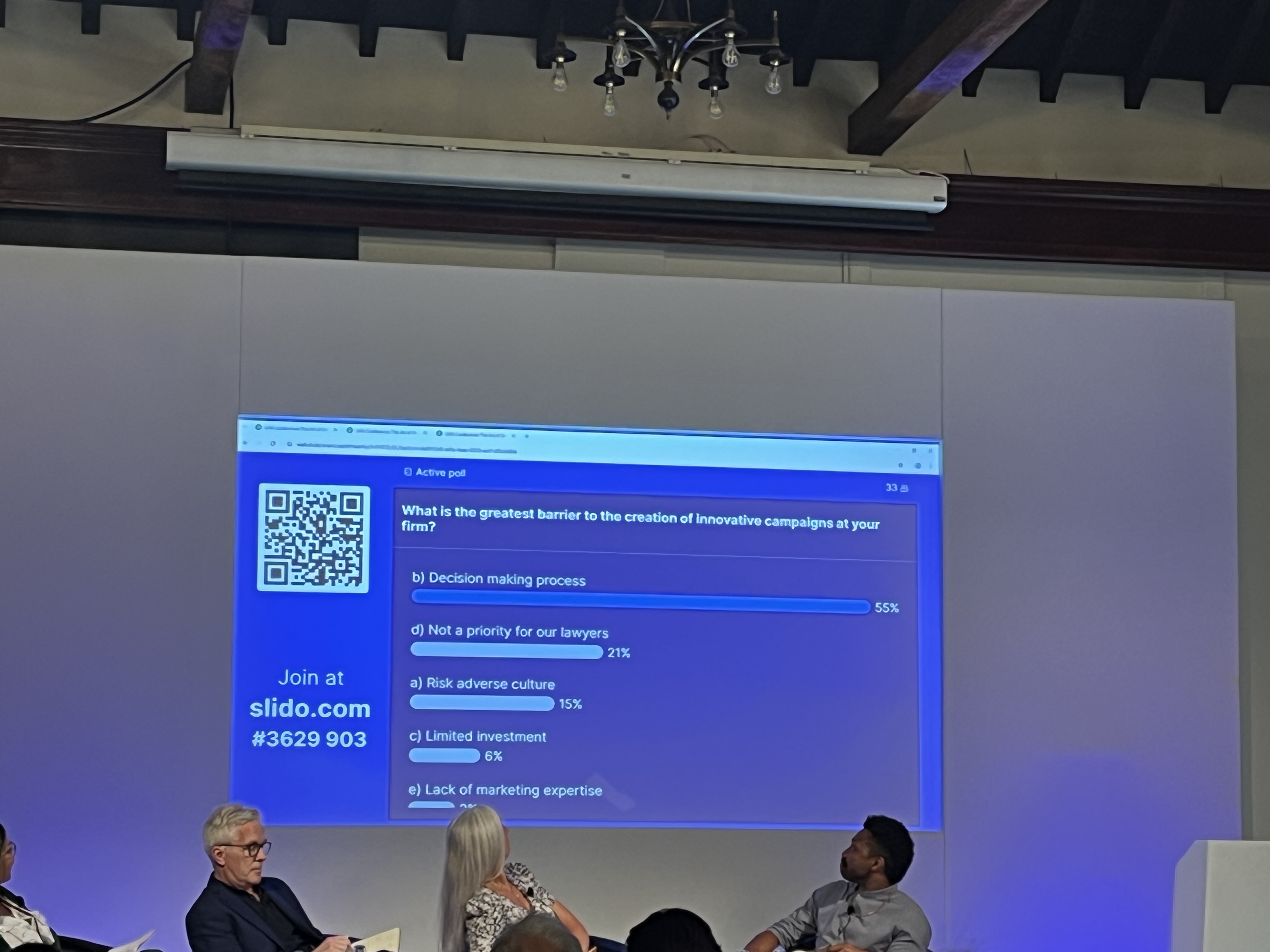In a lively and thought-provoking session moderated by Alessandra Almeida Jones (Global CMO, Bryan Cave Leighton Paisner), the panel explored how legal marketing teams can push creative boundaries while staying true to the realities of the industry.
Brian Macreadie (Head of Marketing, Addleshaw Goddard), John Riley (Global Head of Strategy, MRM), and Emily Gray (Associate Director, Strategy & Campaigns, Baker McKenzie) challenged the idea that legal marketing must always play it safe and showed how bold, strategic campaigns can deliver impact and measurable ROI, even in a traditionally cautious sector.
The discussion offered a practical look at what’s holding firms back, real examples of standout campaigns, and a framework for building marketing initiatives that genuinely differentiate.
The session started with a couple of audience survey questions to set the scene:


The Challenge of Differentiation:
- Law firms tend to engage with topics as they are "falling off the topical curve," meaning the market is already saturated
- Clients receive very similar content on similar topics from multiple law firms, making differentiation difficult.
The Challenge within a partnership model:
- The partnership model creates an environment with numerous individual decision-makers, each with their own interests and agendas, making strategic alignment challenging.
- Partners can find it hard to challenge unaligned ideas from peers, leading to "corporate whack-a-mole" where marketing tries to suppress off-strategy initiatives.
The Challenge within the marketing team:
- Marketing teams are often "stretched" with "9,000 things to do," making it hard to dedicate time to innovation.
- There is a tendency to stick to traditional methods (articles, LinkedIn posts) rather than exploring new approaches.
- Marketing professionals can become "punished drunk" by frequent rejections, leading to a reluctance to propose innovative ideas.
The Extraordinary Cost of Being Dull:
- Unlike other B2B clients who seek distinctiveness, law firms often prioritize consensus, which can lead to "dull ideas."
- If campaigns are dull, they go unnoticed, requiring more spending to achieve the same impact, whereas distinctive campaigns can evoke emotional reactions and stand out.
- Sit up and notice" is difficult within a consensus-driven culture
Principles for Compelling Campaign Creation:
- Campaigns must clearly define the audience, objectives, call to action (CTA), and measurement.
- Beyond the basics, campaigns need to be distinctive, conspicuous, and evoke an emotional response to be memorable and drive action. The task is to make the same topic more emotive than competitors.
Aligning Marketing with Commercial Value:
- Marketing must be positioned as adding commercial value to the business, not just as a "coloring department."
- KPIs should be journey-based, linking engagement metrics to interest metrics and ultimately to the "handshake with BD and sales."
- Continuous, real-time tracking and optimization of campaigns are essential.
Impact of Emotive Campaigns:
- "Out there," emotive campaigns consistently lead to increased attendance at events, positive feedback, more follow-up opportunities, higher click-throughs, and better conversions.
- A great example of a creative and emotive campaign is Addleshaw Goddards GC research where it was found that GC's are well loved in their firms and should be part of firms boards and decision making processes. Instead of just pushing the research, Addleshaws team came up with a campaign around songwriting and what happens if you leave the notes G and C out.
The campaign can be found here
Content Strategy and Differentiation:
- Clients are "really intelligent human beings"; if a topic is "being talked about to death," they've likely read about it extensively.
- Unless we can bring a new perspective, stay away from it
- Content should “say it in a human way and say it in a way that applies to everyone.”
Tailored Measurement and Risk-Taking:
- Tailor the measurement and start thinking of different ways of showing value.
- Marketing professionals are not just employed to spot risk and prevent risk but to drive the business forward and differentiate.
- Innovation should be built up gradually within an organization, meeting the audience "where they are," as a radical idea without trust could just combust.
The session was extremely thought-provoking, and the panelists were very keen to stress the point that you won't get punished for being creative.





/Passle/53d0c8edb00e7e0540c9b34b/MediaLibrary/Images/2025-06-24-15-50-59-531-685ac963d81bf11b7522dd8e.png)
/Passle/53d0c8edb00e7e0540c9b34b/MediaLibrary/Images/2025-07-18-09-58-19-480-687a1abb3f035ba76e3b1135.png)
/Passle/53d0c8edb00e7e0540c9b34b/MediaLibrary/Images/2025-07-16-15-19-02-033-6877c2e69812944070f9b5f9.jpg)
/Passle/53d0c8edb00e7e0540c9b34b/MediaLibrary/Images/2025-07-14-15-26-02-726-6875218a3f3ceaccf87db351.jpg)
/Passle/53d0c8edb00e7e0540c9b34b/MediaLibrary/Images/2025-07-07-10-03-21-698-686b9b69d61027272ff7a1c0.jpg)



